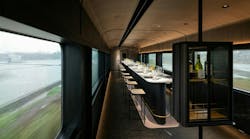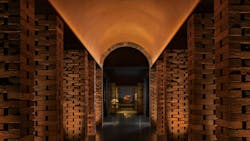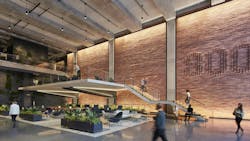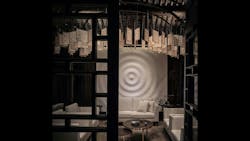IIDA Competition Winners Showcase Transformative Trends
As we gear up for the unveiling of the next cohort of winning projects this April, let’s take a look back at last year's IIDA Interior Design Competition winners, and the movements they helped maintain. All these projects and trends make it clear that the future of interior design is being sculpted by a commitment to innovation that serves both the planet and its people.
Here's what caught our eye from the 2023 winner’s pool.
Integration of Nature and Advancing Sustainability
The CCD Global Headquarters by CCD Design & Architecture in Beijing, and the LAK Concept Store by Unknown Architects in Guangzhou, China, are shining examples of a design philosophy that marries natural elements with sustainable practices. By integrating living green walls, energy-efficient materials, and nature-inspired aesthetics, these projects underscore the crucial role of environmental stewardship in contemporary design and the expanding role of biophilia, as well as the constant evolution of planet-conscious practices, technology and strategies. This trend not only highlights the importance of ecological balance but also enhances the well-being of occupants, proving that spaces can be both aesthetically beautiful and responsible stewards of the planet, both at once.
Flexibility and Multifunctionality
At a time when adaptability is key, spaces like Capitol One Hall by LMN Architects in Washington D.C. (a traditional corporate headquarters turned into a dynamic, mixed-use space created as a cultural hub for the wider metropolitan community) and the 800 Fulton Market office building by SOM in Chicago, embody the essence of multifunctional design. These projects leverage modular furniture, movable partitions, and technology-integrated spaces to cater to a variety of activities, from work to leisure. This versatility ensures that interiors can evolve alongside the changing needs of their users, making each space more than just a setting, but a dynamic environment ready for whatever the future holds.
Human-Centric and Experiential Design
At the heart of The Moving Kitchen (an intimate one-of-a-kind restaurant aboard a train offering a simultaneous culinary and sightseeing adventure designed by JC Architecture & Design in Taiwan), and Dong Fureng House Museum by ZAO/standardarchitecture in Ningbo, China, (a Chinese economist’s former residence that seamlessly blends history and nature within its design), lies a commitment to creating spaces that resonate on a deeply personal level. These designs prioritize sensory experiences, emotional connections and the journey of discovery for each visitor. By focusing on the human aspect of design, they invite a deeper interaction with the built environment, fostering a sense of belonging and a richer, more fulfilling user experience. Over the past year, we've seen an emphasis on crafting unique, memorable experiences that now transcend the confines of hospitality to redefine workplaces, healthcare facilities, airports, and more, extending to all facets of our lives.
Community and Connectivity
Projects like Capitol One Hall and the CCD Global Headquarters are designed with the community in mind, creating spaces that facilitate interaction, collaboration and connection. These projects extend an invitation to gather, share, and create collective experiences, reinforcing the idea that design can be a catalyst for building stronger communities and fostering a sense of belonging among diverse groups of people. As this trend continues to evolve, we envision a future of even more innovative and multifunctional spaces that actively contribute to the cultural and social fabric of the communities they inhabit, bridging gaps and creating new possibilities for interaction and engagement.
Creative Expression and Unique Identity
The distinct artistic visions behind each project, from the bespoke installations in Capitol One Hall to the innovative material use in the LAK Concept Store, demonstrate the limitless possibilities of interior design as a medium for creative expression. These spaces tell unique stories, evoke emotions, and leave lasting impressions on their visitors, proving that interior design goes beyond functional aesthetics to embody the unique identity and ethos of a space.
Overall, the observed trends underscore a paradigm shift in interior design towards solutions that are not only flexible and adaptable to the ever-changing landscape of human needs but that are also deeply ingrained in cultural responsiveness and environmental consciousness. This holistic approach offers up a profound understanding of design’s potential to influence well-being, foster community, and celebrate diversity. As we look ahead, it's clear that the role of interior design will continue to expand, shaping spaces that are not only functional and beautiful but also inclusive, sustainable and deeply connected to the human spirit. This foresight promises a future where design not only reflects our current needs and values but also anticipates and adapts to the challenges and opportunities of tomorrow, ensuring that our built environments continue to evolve in harmony with both our planet and its people.
The IIDA Interior Design Competition (open annually December-February) honors achievement in outstanding interior architecture and design, honoring the use of innovative ideas, techniques and furnishings. Join us in celebrating this year’s winners as well as IIDA’s 30th anniversary this June at Revel in Design, kicking off at NeoCon 2024. Learn more here.



